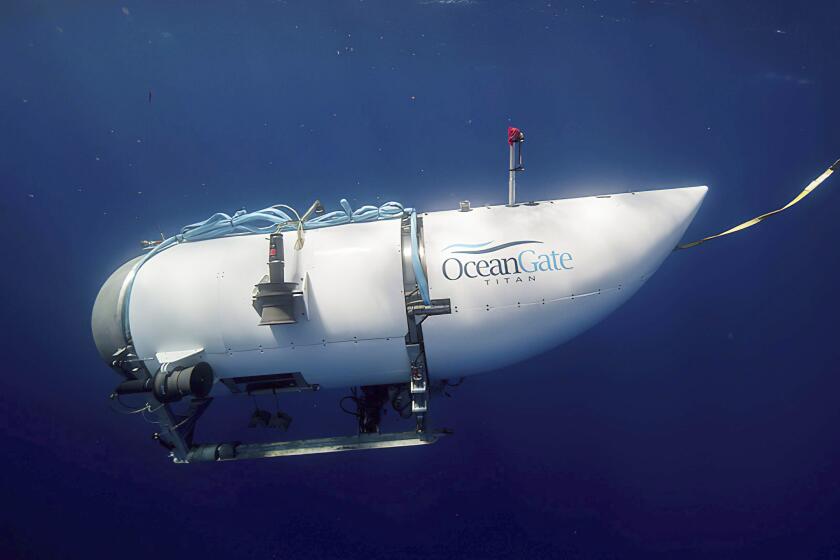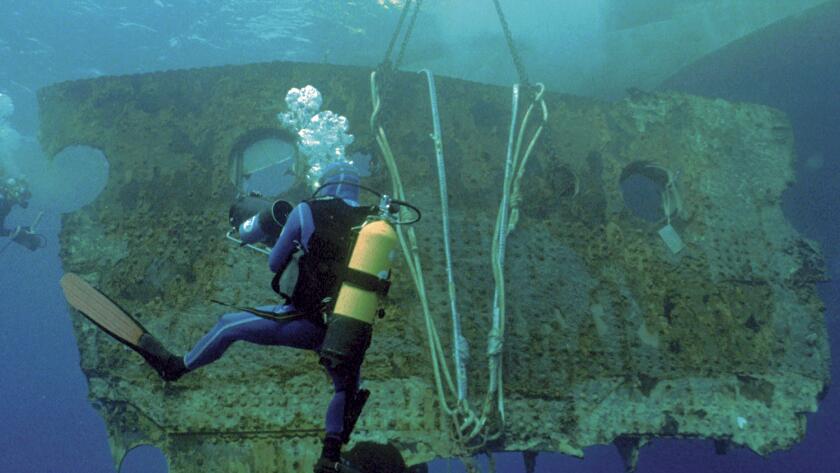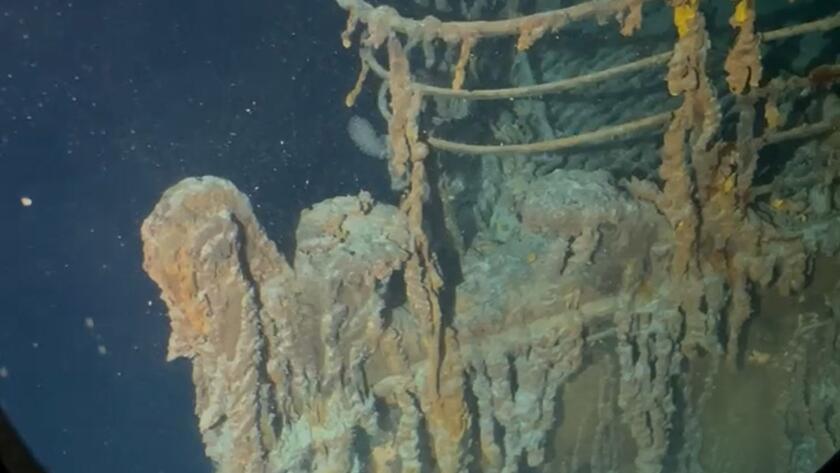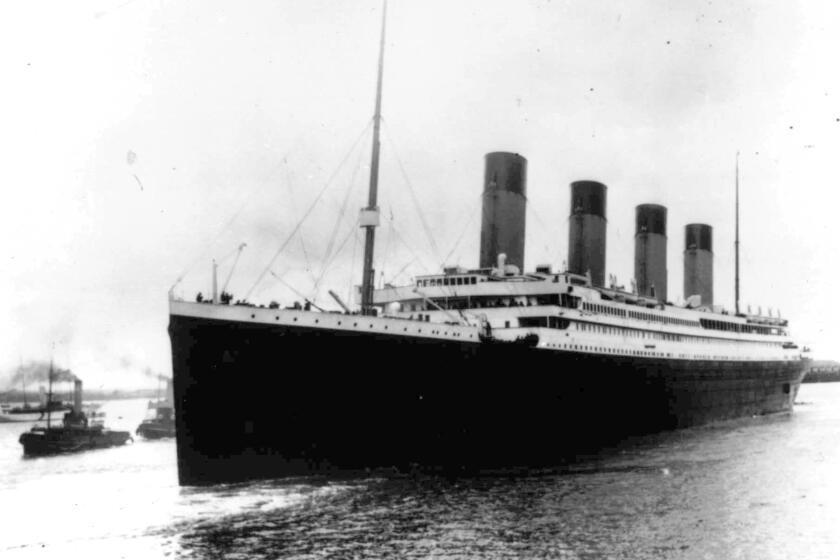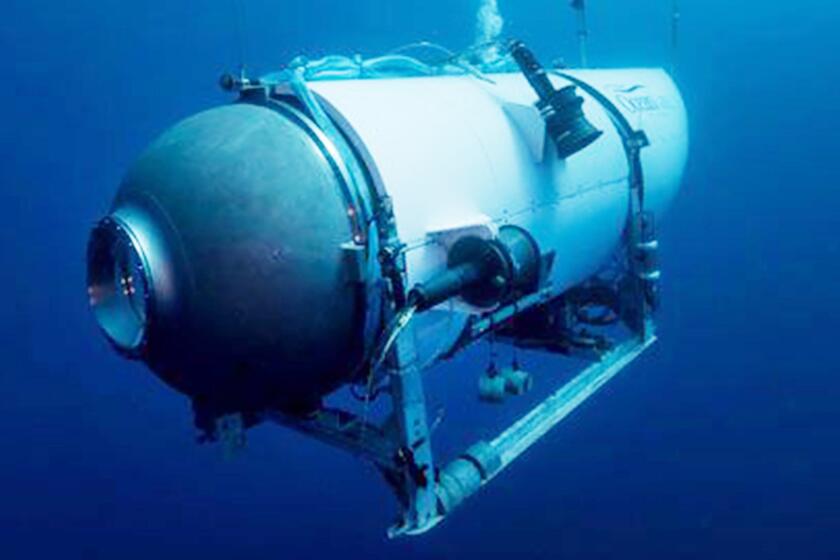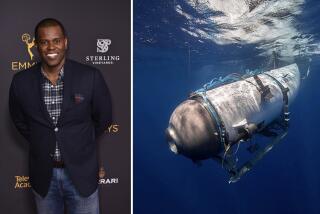Sounds described as ‘rhythmic tapping’ on hull heard in search for Titanic tourist sub
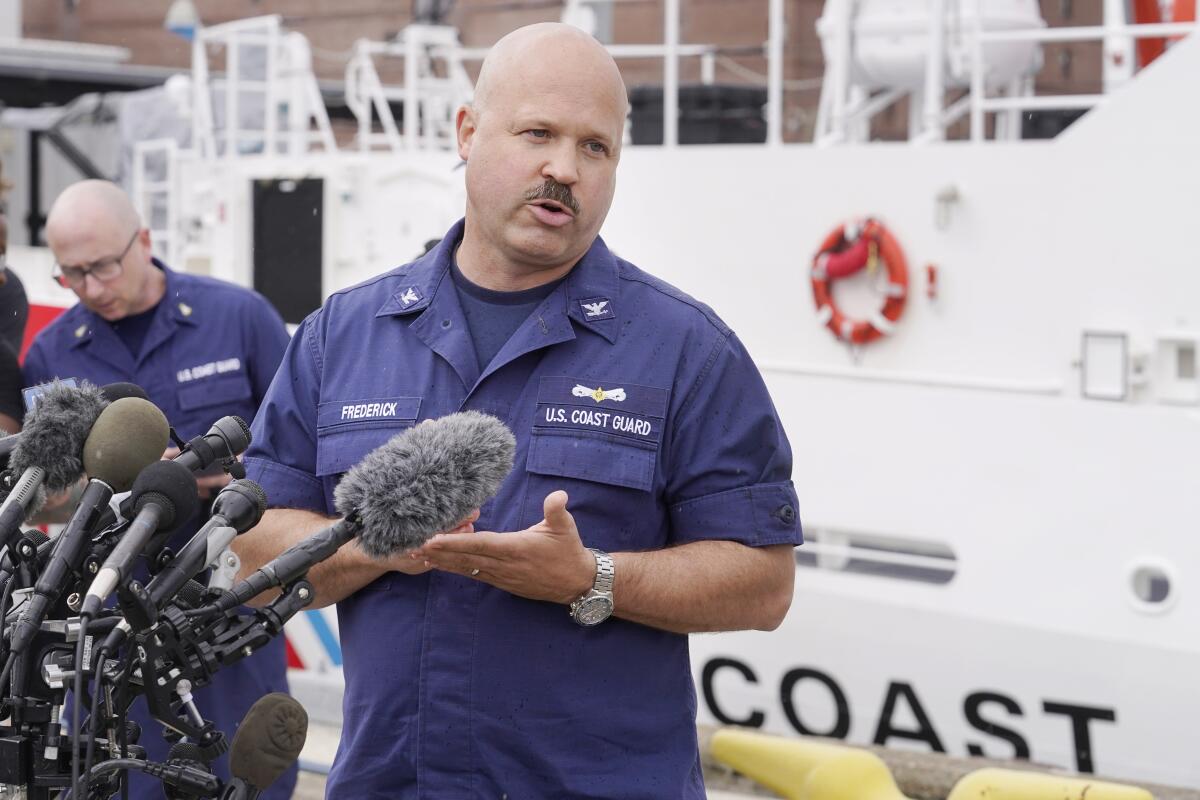
- Share via
With time running out, the intensifying search-and-rescue effort for a submersible that disappeared Sunday in the remote and wild waters of the North Atlantic with five people aboard is bringing in more resources and targeting an area where a Canadian aircraft with sonar capabilities picked up noises two days in a row.
The sounds were first detected Tuesday and heard again Wednesday morning, said Capt. Jamie Frederick, a response coordinator with the U.S. Coast Guard, at a news conference Wednesday.
Five surface vessels and two remotely operated vehicles are targeting the area where the noises were detected.
“Although the [remotely operated vehicle] searches have yielded negative results, they continue,” Frederick said.
More resources were expected to arrive within the next 24 to 48 hours, including five additional surface assets and several more remotely operated vehicles.
An advisor to OceanGate Expeditions, the company that owns and operates the missing 21-foot sub called the Titan, described the sounds as “rhythmic tapping” that are “consistent with ... sounds” of people tapping on a hull. The advisor, who wasn’t authorized to speak on the subject with the media, requested anonymity.
Long before a submersible vanished on an expedition to explore the wreck of the Titanic, concerns were raised about the safety of the vessel.
Frederick did not comment on the specifics of the sounds. “We don’t know what they are,” he said at the news conference.
Carl Hartsfield, a director at Woods Hole Oceanographic Institution who is advising the search efforts, said the noises can be anything. “The ocean is a complex place,” Hartsfield said. “Obviously human sounds, nature sounds, and it is very difficult to discern what the source of those noises are at times.”
U.S. Navy experts are analyzing the noises to determine their origin, officials said.
- Share via
A search-and-rescue mission is underway after a submersible used for tourist expeditions to view the Titanic wreck went missing in the North Atlantic.
The Coast Guard confirmed the noises Tuesday evening on Twitter after Rolling Stone magazine reported that “banging” had been detected at 30-minute intervals within the area where the submersible disappeared Sunday. The report was based on internal emails from the Department of Homeland Security’s National Operations Center that said a Canadian aircraft had detected the noises after deploying several small listening devices called sonobuoys.
In an email, Simone Baumann-Pickering, an acoustic ecologist at UC San Diego, said multiple sonobuoys can be used to localize a sound source. One clue is whether the source is stationary or mobile, she said. The team will be looking at the pitch, duration and repetition rate of the sounds to determine their origin, she wrote.
Frederick said Wednesday that he had not heard that the noises were at 30-minute intervals. He emphasized that the team is continuing to search the area where the noises were detected.
The search area had grown to roughly twice the size of Connecticut and about 2½ miles deep Wednesday, officials said.
Officials remain hopeful and optimistic about their mission.
“This is a search-and-rescue mission, 100%,” Frederick said. “We’ll continue to put every available asset that we have in an effort to find the Titan and the group members.”
Alfred Hagen has taken two voyages on the Titan submersible, which is now missing near the site of the Titanic shipwreck. He describes what the conditions might be like onboard.
Three additional ships joined the search Wednesday: the John Cabot, a Canadian coast guard ship equipped with scanning sonar capabilities; the Skandi Vinland, a commercial vessel from Norway; and the Atlantic Merlin, another Canadian coast guard ship that has remotely operated vehicles, officials said. The Polar Prince, the research vessel that the Titan launched from, and Deep Energy, a Bahamian research vessel, also are on the scene. Canadian and American aircraft are surveying the surface and using sonobuoys for subsurface searches.
The remotely operated vehicles currently diving can reach depths of 13,123 feet, Frederick said. Among the five additional vessels traveling to the area is the L’Atalante, a French research vessel with underwater robots that can operate as deep as 19,685 feet. It is expected to arrive by midnight Wednesday, weather permitting, a spokesperson for the U.S. Coast Guard said.
Alfred Hagen ventured down in the Titan with one of the passengers who is currently missing. Here’s how he described the trip.
Officials have said the search mission is “very complex” and requires expertise and specialized equipment. The U.S. Coast Guard, the U.S. Navy, the Canadian coast guard and OceanGate have established a unified command to lead the effort, which is receiving assistance from countries including France and the United Kingdom and support from commercial vessels.
The crews have been racing against the clock, with the sub facing a dangerously low oxygen supply, and have searched a total of 10,000 square miles since the mission began Sunday. The sub is estimated to have about a day’s oxygen supply remaining, based on the initial air supply of 96 hours. The sub has “limited rations” of food and water, officials have said.
The five people confirmed to be aboard are Stockton Rush, the chief executive of OceanGate and the expedition’s pilot; Hamish Harding, chairman of Action Aviation, a Dubai-based company dealing in aviation sales and acquisitions; Paul-Henry Nargeolet, a veteran and accomplished diver with more than 30 trips to the wreck site; and Pakistani businessman Shahzada Dawood and son Suleman. Harding and Nargeolet are members of the Explorers Club, according to the professional society.
The sub was reported missing after it lost contact with the Canadian vessel Polar Prince about 1 hour and 45 minutes into its dive Sunday morning about 900 miles east of Cape Cod, Mass., the U.S. Coast Guard said.
OceanGate has been running expeditions with “citizen explorers” to the Titanic since 2021 on its Titan sub, according to its website. The trip can cost around $250,000.
But the company has long faced immense scrutiny from industry experts and its own employees over what they said is a failure to adhere to safety standards for the Titan and its Titanic expeditions.
Banging sounds have reportedly been detected in the remote area of the Atlantic where a tourist submersible with five people aboard went missing.
The Manned Underwater Vehicles Committee at the Marine Technology Society, which advocates for marine technology and resources, wrote a private letter to Rush in 2018 calling on him to allow for third-party safety review of the Titan. The letter said the marketing for the Titan was, “at minimum, misleading to the public and breaches an industry-wide professional code of conduct we all endeavor to uphold.”
“Our apprehension is that the current experimental approach adopted by OceanGate could result in negative outcomes (from minor to catastrophic) that would have serious consequences for everyone in the industry,” the letter stated.
William Kohnen, the chairman of the committee, told The Times that Rush’s more cavalier style of innovation troubled industry leaders, who felt compelled to speak out. “OceanGate raised a number of eyebrows and was the subject of many conversations,” Kohnen said.
That same year, David Lochridge, a former OceanGate employee, raised red flags about the Titan in litigation against the company, “particularly OceanGate’s refusal to conduct critical, non-destructive testing of the experimental design of the hull.” Lochridge, a submersible pilot hired to do quality and safety inspections, said he was terminated for coming forward. He said he disagreed with Rush’s decision to “subject passengers to potential extreme danger in an experimental submersible.”
OceanGate said in its own court papers that Lochridge did not accept information provided by a lead engineer on the vessel’s safety. It also claimed that he filed a false report with the Occupational Safety and Health Administration and that he violated his contract by discussing the company’s confidential information with outside parties.
The case was settled in 2018. Lochridge did not respond to a request for comment.
A search-and-rescue mission is underway after a submersible used for tourist expeditions to view the Titanic wreck went missing Sunday with five aboard.
Times staff writer Jeremy Childs contributed to this report.
More to Read
Sign up for Essential California
The most important California stories and recommendations in your inbox every morning.
You may occasionally receive promotional content from the Los Angeles Times.
